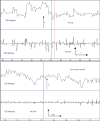Eye muscle surgery for infantile nystagmus syndrome in the first two years of life
- PMID: 19997564
- PMCID: PMC2788587
- DOI: 10.2147/opth.s7541
Eye muscle surgery for infantile nystagmus syndrome in the first two years of life
Abstract
Purpose: To report visual and elctrophysioloigcal effects of eye muscle surgery in young patients with infantile nystagmus syndrome (INS).
Methods: Prospective, interventional case cohort of 19 patients aged under 24 months who were operated on for combinations of strabismus, an anomalous head posture, and nystagmus. All patients were followed at least nine months. Outcome measures, part of an institutionally approved study, included Teller acuity, head position, strabismic deviation, and eye movement recordings, from which waveform types and a nystagmus optimal foveation fraction (NOFF). Computerized parametric and nonparametric statistical analysis of data were perfomed using standard software on both individual and group data.
Results: Age averaged 17.7 months (13.1-month follow-up). Thirteen (68%) patients had associated optic nerve or retinal disease. 42% had amblyopia, 68% had refractive errors. Group means in binocular Teller acuity (P < 0.05), strabismic deviation (P < 0.05), head posture (P < 0.001), and the NOFF measures (P < 0.01) from eye movement recordings improved in all patients. There was a change in null zone waveforms to more favorable jerk types. There were no reoperations or surgical complications.
Conclusions: Surgery on the extraocular muscles in patients aged less than two years with INS results in improvements in multiple aspects of ocular motor and visual function.
Keywords: anomalous head posture; eye muscle surgery; infantile nystagmus.
Figures




References
-
- Norn MS. Congenital idiopathic nystagmus. Incidence and occupational prognosis. Acta Ophthalmol (Copenh) 1964;42(4):889–896. - PubMed
-
- CEMAS Working Group . In: A National Eye Institute-sponsored workshop and publication on the Classification of Eye Movement Abnormalities and Strabismus (CEMAS) Hertle Richard W., MD, editor. Bethesda, MD: The National Eye Institute Publications, The National Institutes of Health; 2001.
-
- Hertle RW, Dell’Osso LF. Clinical and ocular motor analysis of congenital nystagmus in infancy. J AAPOS. 1999;3(2):70–79. - PubMed
LinkOut - more resources
Full Text Sources

